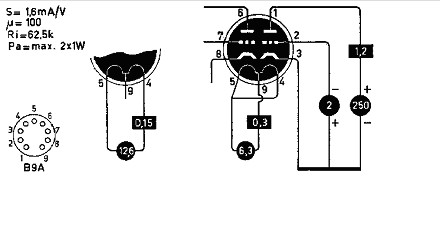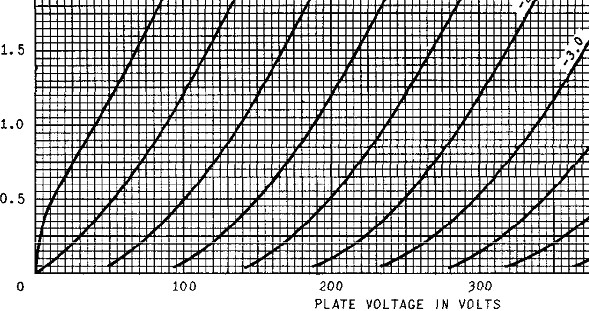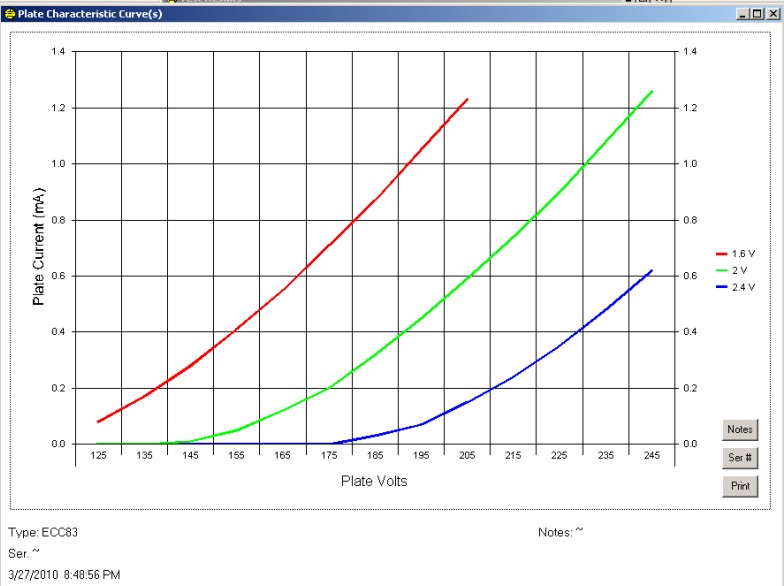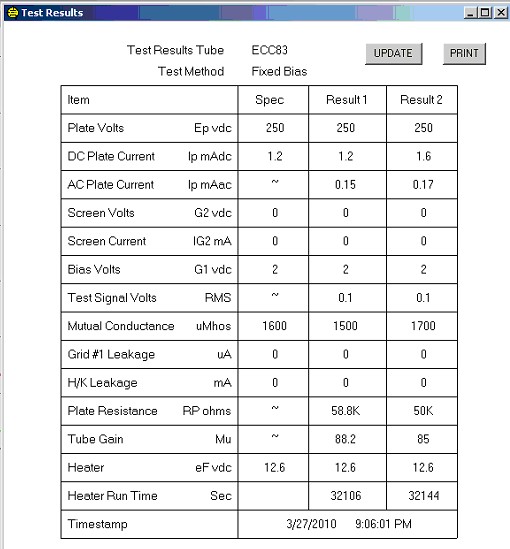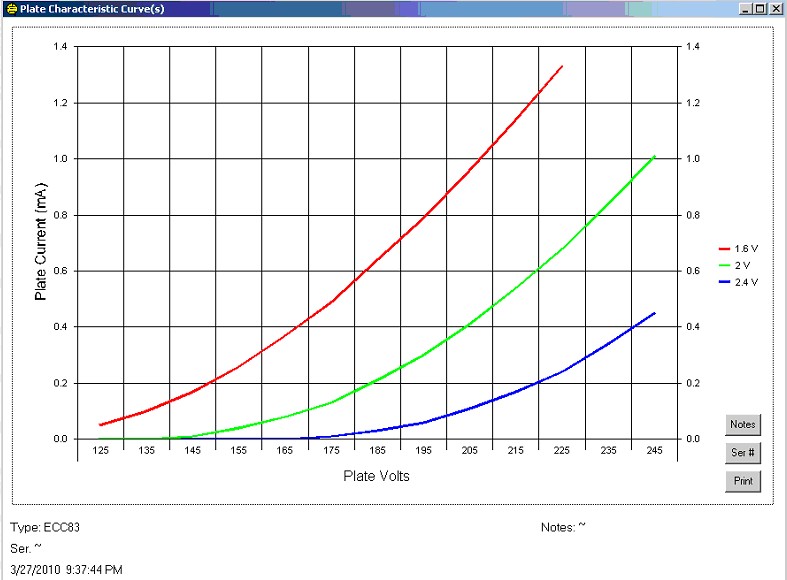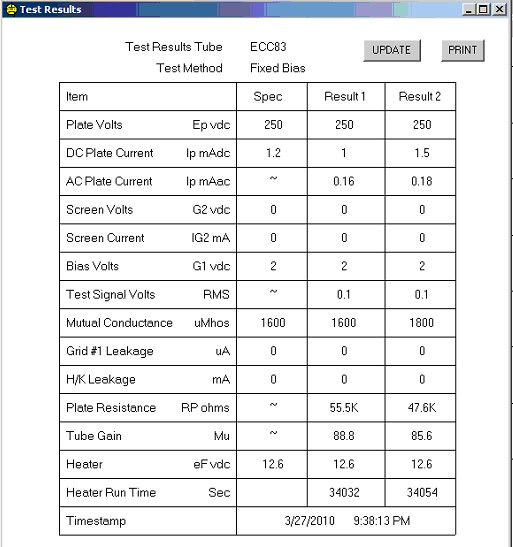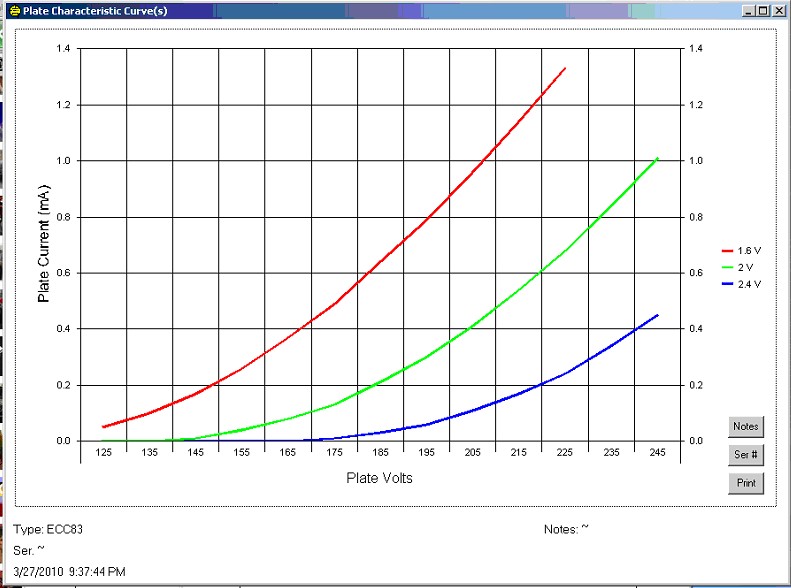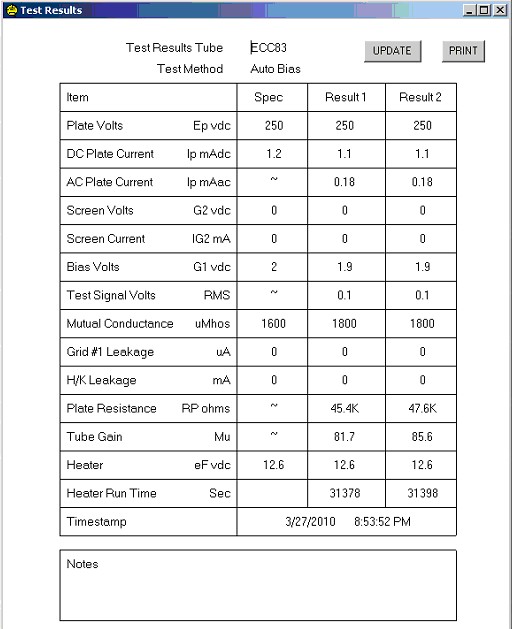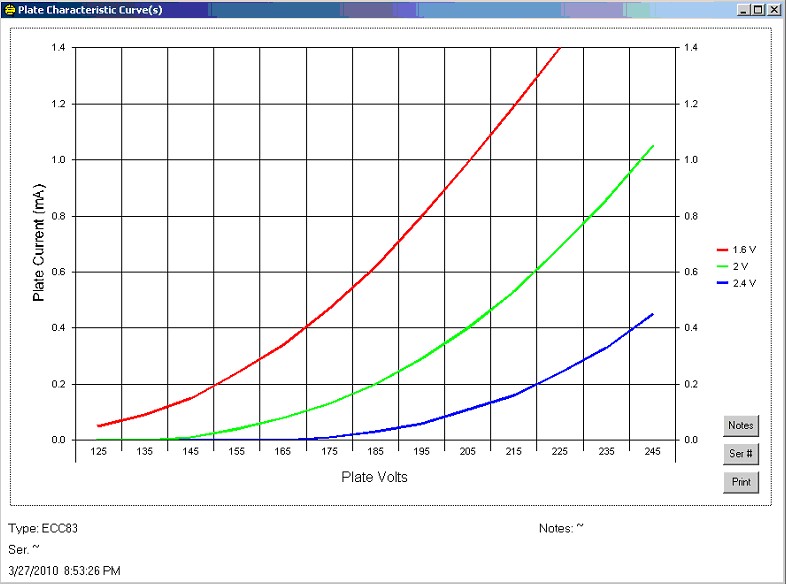How to test ECC83 - E83CC - 12AX7 - ECC803S
JACMUSIC. Since 1993. All rights reserved. Copyright note
This article about how to test ECC83, and I want to show you here some of the different constructions and what test results they result in. It should come as no surprise, that this can best be seen, when using the correct test method. Unfortunately there is a lot of amateur created misunderstanding about how to test ECC83. This is so wide spread, that chances your ECC83 were tested by the seller, the wrong way, is almost 100%. This is really a pity, and not needed, because old data sheets describe exactly how this has be done, but the problem is widely spread general refusal to read those in detail. It is enough for 99.99% of the users to have a look at the "typical" data, which is all they are interested in. Even manufacturers of test equipment do not read it, and then the mess keeps continuing. So some text will be about this subject, the rest is about testing the tubes.
Information article about ECC83 and others
First we start with this standard data, from the Muiderkring book. This datasheet picture shows the way an ideal tube would bias. The complete book you find on www.4tubes.com. About testing with fixed grid voltage.Let me tell you, testing with fixed grid voltage is not in accordance with any tube DATA SHEET ever made. On forums, where you can read about "how to test", often people are talking about things they are intrigued about, and want to let others know about this. If it seems you can learn something from exited newbees, it is not a good sign for your own knowledge level. But also, these people will put you on the wrong track rather than help you any further. There never was any data sheet produced which tells to test at fixed grid voltage. Though this is better than nothing of course, it is still essentially wrong to do, and for sure you will be judging the tubes not the right way. Meaning, what you think are "not so good" tubes, can be great items, and vice versa just as well. The results are confusing, and seldom accurate. So why do people use fixed grid voltage?Well that is quickly explained: The test circuit is easy. The way to operate is easy. It is passive, anyone can do it quickly, and you need to know nothing about what causes failures. These are a few simple reasons for it. It's all about convenience. So is there a better way? Guess what..... Yes, there is! You can easily find that out, by reading old data sheets. Commercial Data sheets vs industrial Data sheets.95% of the data sheets are commercial, the other 5% is for quality items. Commercial tubes have no quality in the sense of the word, because quality means specifications which are on paper and which can be verified by the user. Typical data, you can't verify, because what is too high or too low, they don't tell you. When a tube has no incoming inspection procedure in the data sheet, it is by definition not a quality item. It is commercial in that case. Like the manufacturer says it's "good" but it is left open what that means. So if incoming inspection criteria is missing, it's what we call a commercial tube. That is the lowest grade there is. Also you need to read the introduction text of the data sheet. That describes often in clear language what the tube is intended for, and what you can expect from it. Read for instance a "five star" data sheet from GE, what these tubes are made for, and compare that to a similar tube from Electro Harmonics. Or even a JJ tube, which has nothing to say there, and prints typical data tables right away. That will open your eyes, I hope. Data sheets of commercial tubes have only "typical" data. That means a typical plate current, is the result of a typical grid voltage, when using a typical plate voltage. Then when each of these three numbers are TYPICAL indeed, by (great) coincidence, then and only then, the typical transconductance will apply. In all other cases, the typical transconductance will NOT apply, and you can't say much about the whole tube any more. So convenience yes, but on the cost of a vague result. Data sheets of industrial tubes have "limiting" data. Industrial tubes can be better constructed, like for instance Tesla E83CC, but most of the time they are only different tested. Called uptesting. Those that fail go in the bin with commercial tubes. It gets evil when even that is not done, so an industrial part number is printed on plain commercial tubes. This is standard practice today with some Russian tubes. WIth commercial tubes, though this is not really possible, users are in need for some inspection criteria. The manufacturer never published that, and tested the tubes whatever way, but no information is given. So any self made test criteria is nice for yourself, but only that. Still for better testing, consider the data sheets of equivalent industrial tubes, and test by that. Tubes which don't pass, you can stil throw them back into the box with commercial tubes, where they came from.. You can do yourself a great favour, studying the TELEFUNKEN ECC803S data sheet, and read there how ECC803S has to be tested. Do you really think, that is with -2V fixed grid voltage? Of course not! You really should have a closer look at the TELEFUNKEN ECC803S data sheet. You will find in there an AUTO BIAS circuit, with 1k6 bias resistor, and grid voltage of zero volt. THAT is how to test ECC83. Not invented by my, but by Telefunken. Any other way to test, is not given in any original data sheet. Then, in that circuit, Ia = 1.25mA +/- 0.15mA. Nothing special about it, because in any auto bias circuit, the tube is "good" when the deviation is appr. 10%. It may come as a big surprize to you, to see ECC803S has to be tested AUTO BIAS, and not with fixed grid voltage, but that's the way it is. |
|
About published tube curvesToday, we have tube curve analysis programs, which can derive the essential "DNA" from the tube curves, and with that re-draw the tube curves itself. Why are we doing so? Well, the fun part of this is, we can detect hand made corrections, or in other words: fake tube curves. I did not have time for it yet, but I suspect these GE curves from this.
Here is a detail from the same datasheet. Look at those nice, parallel lines, with their well defined cut off points. So the lines do not point all to some vanishing point, as with real life tubes. The distance between each line is the same, regardless where you look. This means the tube has no distortion. Now with amplifying devices, distortion and gain go hand in hand. So for a tube with very high (100x) gain, some distortion is NORMAL. However, not so when looking at those GE datasheets here. Wow! they have no distortion. How did they do that? Well for drawing such curves they used a flexible ruler. Those you can bend it in any desired shape to draw curves. Anyway, these curves show how an ideal tube must look like, but how ideal are they in real life? Lets see what I measured with the AT1000 curve tracer, and a nice collection of NOS and NEW made tubes. GENERAL IMPORTANT REMARKS ABOUT ECC83:Ever since I test NOS ECC83 and 12AX7, I find that the average of new production is not at 1.2mA by the text book. The average is always around 1.1mA. Also for new tubes, and 1.0mA is often seen. Don't ask me why that is, but it is so with NOS and NEW tubes. This would be a problem by itself, as plate current at fixed grid voltage is no reference for anything, just the thing is, the AVARAGE must be 1.2mA, and that is not what it is. Perhaps NOS tubes are getting too old. The only tubes which seem to come out of the boxes ALL as Bogey tubes, are TESLA and SIEMENS&HALSKE TRIPLE MICA E83CC. This is the most incredible good testing tubes I have ever seen. These outdo ANY BRAND WHATSOEVER.The test data was taken with the Amplitrex AT1000. This digital unit has 10bit resolution at full scale, which is 0.1% but specially at the end of the scale resolution gets kind of "digital" so it shows "steps", which can be seen at the lower end of some curves. The low scale is 10mA, so digital steps are 0.01mA. No problem at 10mA, but it gets visible below 0.5mA of course. Also the transconductance is always ending on "00". So steps are like 1500, 1600, 1700, etc, and a tube with 1600 -1700 on both systems is in reality for instance 1641 -1692. No problem, as long as we know it. I verified the AT1000 results against the higher resolution Russian L3-3 and the AT1000 is very accurate. When you compare the graph with the test data, of course you will find the test data from the table in the curves, since it's from the same tube. The curves are made from System1 , not System2 . Look just above the number 195 at the blue line. The measured value is right above that number 195. So not at the left or the right. It's a bit unusual, but it's how the AT1000 works, the software for the graphs is a Microsoft module, called MSCHART, the Amplitrex builder told me, so that explains it. ABOUT ECC83 TEST DATA IN GENERAL:Look at the test data. The tube is set for -2Volt grid, and then at 250V plate the tube is tested So the plate current is exactly 1.2mA on both systems. This is no "Must", and in reality most tubes have a deviation of +/- 0,3mA and are fine tubes still. Also Tesla can have some deviation. The transconductance is exactly right 1.6m/V. Next thing is something O observed more often: Gain is a bit lower at around 80...85x. I don't know what that is, but I seldom find an ECC83 with a gain if 100x and when I do, it's a bit funny testing tube anyway. Plate impedance is a bit lower than average, this is normal too, and plate impedance goes up somewhat while a tube ages, and transconductance goes down. These two things together keep the gain constant while the tube ages, since gain is Rp x transconductance. So the data table is very nice TUBE CURVES Each tube curve by itself is a genetic fingerprint, meaning it holds the data for the other curves too. So we draw only tree curves, it is enough, and otherwise the plotting of all those curves would take too long.
|
|
NOW FOR THE BIG ECC83 / 12AX7 TEST: |
|
TESLA E83C
What you see here, is a reference tube. Few tubes come near to it. From what I know, only E83CC Siemens and Halske is as food. The curves are even better as the cosmetically hand-corrected General Electric curves. What do we see?
|
|
JJ-E83CC
First thing we see with the JJ is the remarkable difference between the system 1 and 2. This comes from not well adjusted tools in production, or perhaps from other reasons, but whatever the cause, the tube systems 1 and 2 are mechanically not the same. It is a matter of taste if you tolerate this. |
|
JJ-E83CCThe curves do not compare to the NOS TESLA. Note, the JJ E83CC is a mechanical copy of the TESLA E83C. So what we see here, we have a NEW production JJ, and the curves are less nice as an NOS TESLA that was unused in the box for 40 years.
|
|
Telefunken ECC83
|
|
Telefunken ECC83This is a new out of the box Telefunken, with older Type black on white box. On the bottom is a special sticker with pink ink saying 22.4.1950. I wasn't seen born then. So here comes this tube out of the box, and I put it on the Amplitrex AT1000. It shows one triode has another plate current. The difference is 0.4mA. It is as much as the JJ, which have a bit of a bad reputation for this. However, we must stay realistic, we cannot retro-define a new standard. Such deviations were normal 60 years ago, as we can see from this NOS. For the rest, this tube is pretty much average with the data. Simply good, no more and no less. The good thing of the Telefunken is the very high lifetime expectation, lowest hum and lowest noise. For more constant parameters, the TFK ECC80S is the tube, since ECC803S is defines as having maximum 15% Deviation. (Per Triode that is, so 30% between the two)
|
|
Electro Harmonix ECC83
Electro Harmonix ECC83This is a reasonable tube, but not the best for HiFi. They make this tube with slightly different data on purpose, to get a special kind of distortion, in amplifiers for electric guitar, which their chief engineer JC Morrison refereed to me as "brown sound". WIth older lots, I had vacuum problems during storage. This was not solved by EHX satisfactory.
|
|
| WILL BE CONTINUED! | |
